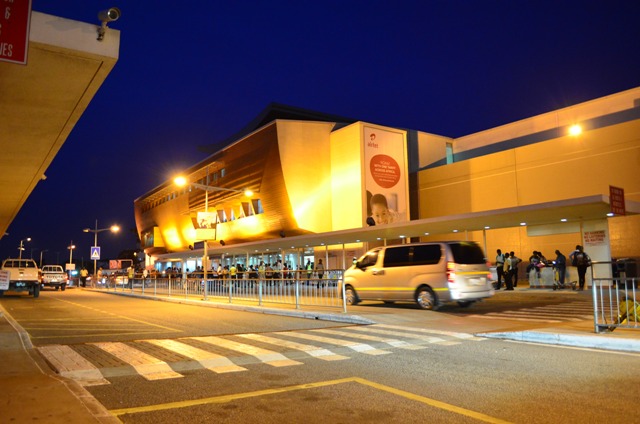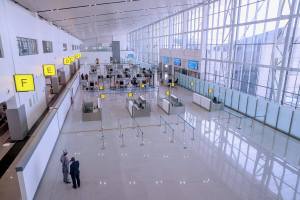“Africa has turned the page to the next chapter in aviation development,” says Mr. Ali Tounsi, Secretary General, of ACI-Africa, who, in this exclusive interview with Aviation & Allied Business outlines what African airports require to excel in a liberalized air transport market.
Q: Would you say African airports are ready for the Single African Air Transport Market (SAATM) and liberalization of air transport market in Africa?
A: Africa is often described as a sleeping giant poised for a mass awakening. There is no denying that Africa is a diverse continent culturally, politically and economically, all factors that favour greater throughput at African airports.
Further liberalization and competition across all sectors of air transport is vital to enabling access to new markets within and without the continent. That is, a loosening of regulatory constraints in aviation policy would create fertile grounds for enhanced connectivity and investment in Africa. The implementation of the Yamoussoukro Decision in 1999, aimed at deregulating air services, has been slow and limited. The potential benefits of liberalizing intra-African air markets have thus remained largely unrealized.
Africa has turned the page to the next chapter in aviation development. The African Union launched the Single African Air Transport Market (SAATM) last year, which could further improve the region’s aviation prospects to open the skies. The growing commitment to a common aviation market will alleviate existing regulatory constraints. It is expected that the policy will improve consumer choice, enhance competition across the air transport value chain and augment connectivity on the continent. Over the long run, this would result in overall net gains for the continent’s aviation sector and the economies it serves.
Q: In what ways is ACI supporting African airports to excel in this unfolding market-place in Africa?
A: ACI-Africa is constantly developing ways to support the growth of our members. Training and human capacity development is one of the major ways in which we believe our members can unfold and maximize the abounding opportunities available. Our Developing Nations Assistance fund and the airport development program give our members the opportunity to enjoy free trainings and scholarships centered at improving their skills. In 2018, 400 airport professionals participated in our free trainings in various locations across the continent.
In addition, ACI Africa has in recent years allocated more resources to hosting various events around developing airports’ commercial revenues. In fact, ACI’s upcoming Regional Conference and Exhibition, taking place in Luxor, Egypt, from 4-10 March, will have as its theme: “Boosting Airport Growth with Non-Aeronautical Revenues.”

As compared with the previous year, airport revenues developed steadily in Africa with a growth of 12.6% in 2018. This was mainly driven by 16.1% increase in aeronautical revenue. Africa has the greatest reliance on aeronautical revenue than any other Region. This matters because non-aeronautical sources of revenue generate a higher profit margin and thus contribute more to financial sustainability and the capacity to withstand traffic volatility. Revenue diversification has proven to be essential in helping airports weather the dynamic market changes they must endure.
Q: Public-Private Partnerships (PPPs) have been seen as a preferable way of boosting airport infrastructure and development. Yet there have not been much success in this regard. How can the benefits of PPPs be boosted among African airports?
A: ACI does not prescribe any specific type of ownership or management model. A range of objectives may lead a government to consider privatization as an option. As some objectives may conflict, the government’s specific policy objectives and their relative weighting should guide the choice of privatization model. Since every privatization embodies a unique combination of government goals and private investor requirements, no single privatization model fits all circumstances. The privatization model used depends both on government objectives and the requirements of the private operator/investor(s) the government hopes to attract. A balance needs to exist between transferring the risk of financing large capital expenditures from governments and tax payers to private sector investors, on one hand; and private sector requirements to recover the costs of operating airports and generate risk proportionate returns on investment, on the other.
Q: There is much emphasis on improving customer experience as a strategy to improve competitiveness for airlines and airports. How do you think African airports can key into this concept to gain its benefits?
A: Airport competition is a fixed feature of the industry, and the market power of airports has decreased as increasingly airlines pick and choose between various airports and destinations, moving aircraft, routes and bases. Airports compete with other airports for freight, connecting passengers, aircraft technical stops and for the services of low-cost carriers, and this situate specifically with other airports in the same region for origin and destination passengers. This competition has forced airports to put a particular focus on the customer experience as the relationship between customer satisfaction and revenue is crucial. This relationship has long been fundamental in the analysis of airport business performance.
With stronger competition, the notion of excellence in customer experience has become even more important in comparing airports. Recognizing that passengers are demanding more customized services based on their specific needs, requirements and tastes, and the importance of having an airport culture of customer experience in collaboration with the airport community, which requires involving and including all various airport stakeholders to truly be effective, ACI urge States to take, in many respects, measures aimed at facilitating and boosting the sector.

New Terminal at the Nnamdi Azikwe International Airport, Abuja, Nigeria
Customer satisfaction is not only related to the quality of infrastructure and the overall ambience, but also the quality of human interaction. ACI is committed to maintain the continuous enhancement of its efforts to help airports safeguard the passenger journey, including the expansion of tools and services helping airports monitor and improve service culture and alignment of the multiple range of role players regulating and operating on the airport platform. This is being done through a host of Airport Service Quality (ASQ) products and services. ACI’s ASQ, the most comprehensive global programme to survey passengers at the airport on their day of travel, started in 2006 and is now providing both the arrival survey, the departure survey, the Commercial Survey and the Employee Survey for Customer Experience.
ASQ is subscribed to by 375 airports covering over 70% of the world’s passenger population. We deliver the survey to 85 countries in 42 languages. Over the years, with airports both concentrating on the passenger experience in their airports and using the information they get from the ASQ survey, the average ratings by passengers has steadily climbed, even on such touchpoints as the security checkpoint. Our team of experts in customer satisfaction are committed to support our members in Africa to help them achieve their performance objective and remain competitive on the regional and global scene.
Q: Airlines are major stakeholders and users of airports. Yet the disagreement between airports and airlines on airport charges and taxes tends to be ever-present. How can this be resolved?
A: Today, the economic sustainability of the airport industry is dependent on the capacity of airports to recover their aeronautical costs from the users, in line with national legislation and ICAO’s Policies on Charges for Airports and Air Navigation Services in Doc 9082. Airports are a critical part of the economy of the State within which they are located. They serve as engines of growth for their local, regional and national economies. Consequently, in an increasingly commercial and competitive business environment, airports must be able to collect sufficient revenues to finance their investments in airport infrastructure and operations, and to maintain a level of service which is broadly acceptable to all airport users, including passengers and aircraft operators, and to serve the local community. Adequate airport infrastructure is a core enabler of air connectivity, passenger service quality and social and economic growth. As per the “user pays principle” this needs to be paid for via airport charges. It is therefore essential that airport charges properly reflect market realities and deliver on the longer-term needs of the ultimate end-users.
Q: Most if not all African airports produce less than 50% of non-aeronautical revenue despite the potentials in this regard. What do you think is the way forward?
A: Today, African airports are facing several challenges for growth. According to the ACI Airport Economics Report 2018, airport revenues developed steadily in Africa in 2016 with a growth of 12.6%. Non-aeronautical revenues grew at a rate of 7%, but accounted for only $900 million dollar in 2016, an amount significantly lower than the other regions. The commercial side of the airport business in Africa is unfortunately poorly exploited and under-valued and this situation is preventing the industry to prosper and become competitive. In 2016, airport revenues per passenger in Africa were as low as $4.76, compared to $13.44 for aeronautical revenues. Clearly, a change of culture is needed more than ever in this particular region in order to address this gap.
Commercial revenues can be a stable source of revenue that can help recovering operating costs and reduce the use of aviation taxes for future airport development. To tackle these issues and to boost retail spending, African airports should turn to data analysis to understand passenger flow and behavior. The use of advance analytics must be leveraged in this regard.
For this reason, airports in this region must develop partnerships with governments, brands and retailers in order to increase these numbers and respond to the growing demand of travellers. The commercial or non-aeronautical sources of income such as retail concessions will significantly contribute to the diversification in an airport’s income portfolio and provide an additional cushion during adverse economic times.
Q: Africa still contributes less than 2% of global air cargo. How do you think Africa can increase the sources and volume of air cargo?
A: The African economy gained momentum in 2017, benefiting from the cyclical recovery in global trade according to our most recent World Annual Traffic Report. Air cargo volume for the continent as a whole grew 9.2% in 2017. It appears that air cargo is highly concentrated in a handful of African airports. The substantial increase in volume is attributed in large part to South Africa, the continent’s second-largest economy. It handled a 19% share of the overall volume and remains the leading air cargo market in Africa.
That being said, air cargo development and traffic are linked to, and influenced by trade policies between countries and national regulations. Regulation policies affect the volume and character of air transport services and thus have a major impact on airports. Consequently, liberalization should be welcomed to improve connectivity to the benefit of the economy and the society. New regulatory arrangements should take account of airport capacity considerations and other interests in determining service levels, and should not erode or restrict airport proprietary rights. For these reasons, airports should be fully involved in the process as they should always be represented in national delegations to air services negotiations. Investing in infrastructure and technology to move products to markets efficiently is also essential.
From an operational perspective, ACI and IATA have partnered to create an innovative initiative by the name of New Experience Travel Technologies (NEXTT). NEXTT aims at shaping a future vision for air transport and this includes cargo operations, drawing from current innovations and looking towards future technologies.
Q: Airports certification has been recommended by ICAO; yet many African airports are yet to get certification. How can this be resolved?
A: Safety is ACI’s top priority and we fully support the International Civil Aviation Organization’s (ICAO) No Country Left Behind initiative and its Global Aviation Safety Plan which supports the prioritization and continuous improvement of civil aviation safety.
ACI has successfully drawn together experts from around the world in its Airport Excellence (APEX) programmes to both help airports in developing countries to address their problems and to move towards certification; and, to provide assistance to airports elsewhere to further improve their processes, such as through the introduction of safety management systems.
To further develop expertise, ACI also has a Safety Assessors Training Programme (SATP) which is carried out through capacity building, leading to the creation and/or enhancement of expertise in airport safety and regulatory compliance, mentorship and network growth, the enhancement of airport safety levels and promotion of airport excellence.
As such, ACI Africa offers a development programme to help and assist member airports to improve and respond to challenges and achieve professional excellence in the application of international standards and best practices. Each ACI Africa member airport can benefit from this programme according to the priorities and availability of funds. But funding isn’t the only aspect of the development programme, it also includes training, technical assistance, and capacity building and expertise development through access to ACI Global Training and the APEX programme.
Q: How do you assess security at African airports generally, and what do you look forward to for African airports and also for ACI-Africa in 2019 in terms of security and cooperation?
A: Security remains a top priority for airports and for ACI. With the current global security climate, the industry is again stepping up to improve measures to safeguard and secure its passengers, staff and facilities and ACI is committed to help put Africa’s airports on global route map. In pursuit of promoting secure airport operations and cooperation between ICAO, aviation stakeholders and airports worldwide, ACI has developed the APEX Programmes, which currently includes APEX in Security. The ACI APEX in Security review combines the mandate for regulatory compliance with the actual day to day operational needs of airports.
One critical threat facing African airports is that of attacks happening in the landside, public areas. Airports should agree on scope, responsibility and accountability for landside security measures with their appropriate regulatory authorities. Effective landside security should consider infrastructure and airport design features with the goal of mitigating the threat from attack, harm to personnel or disruption of airport operations. ACI published a Handbook on Landside Security in 2018 to assist member airports in building appropriate mitigations and keep operations going.
Another evolving threat which African airports must keep under constant review is the insider threat. Most airport staff conduct themselves in an ethical and professional manner. However, the rare occasions when staff exploit their positions of trust to harm the organization and others pose a major security challenge for airports. To address the range of insider threats and what to do about them, ACI will publish a new Security Handbook on “Mitigating the Insider Threat” in April 2019.
Q: What key areas do you want airport investors and African governments to focus on in 2019?
A: African airports are willing to invest in their current retail areas whilst developing their income portfolio by creating new revenue streams. This has become a widely recognised strategy across all airports regardless of size. Understanding the passenger, their spending habits, and the overall performance of the non-aeronautical sector will continue to play a crucial role in the financial growth of airports.
Investment in airport infrastructure is critical to African economies. If governments in this region cannot afford to invest, other sources must be tapped to accommodate traffic growth. This has been a driving force behind airport privatizations worldwide. But for that to happen, African governments need to consider incentives to attract potential national and foreign investors and provide the clarity investors need on the issues they face. Investors expect a reasonable return to incentivize future investments in airport facilities and operations. They should be able to run an airport as a business and generate returns on investment from both aeronautical and its commercial revenues.
ACI is convinced that the sustainable development of airports in the region requires a change in focus. African airports have the potential to be generators of economic growth. To enhance these roles and to continue to reap the benefits, African airports must ensure sustainable development that includes harnessing the benefits of non-aeronautical revenues as a critical contributor to African airport’s revenue stream and bottom line. As crucial components of the air transport system, their sustainability requires flexibility and, most importantly, evidence-based policy making underpinning it. Airports, airlines and retailers can form joint partnerships and initiatives in order to create an integrated retail experience and boost their non-aeronautical revenues to ensure business continuity of the industry.

